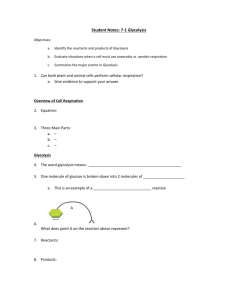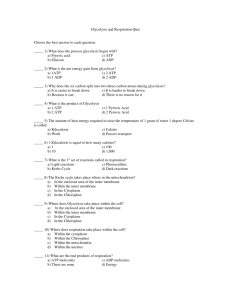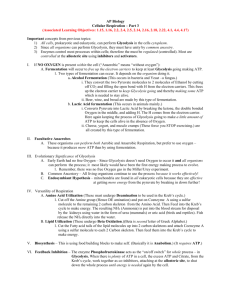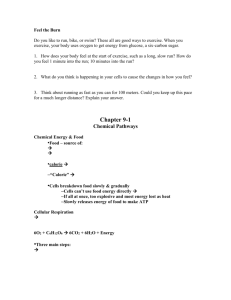Glycolysis - Deans Community High School
advertisement
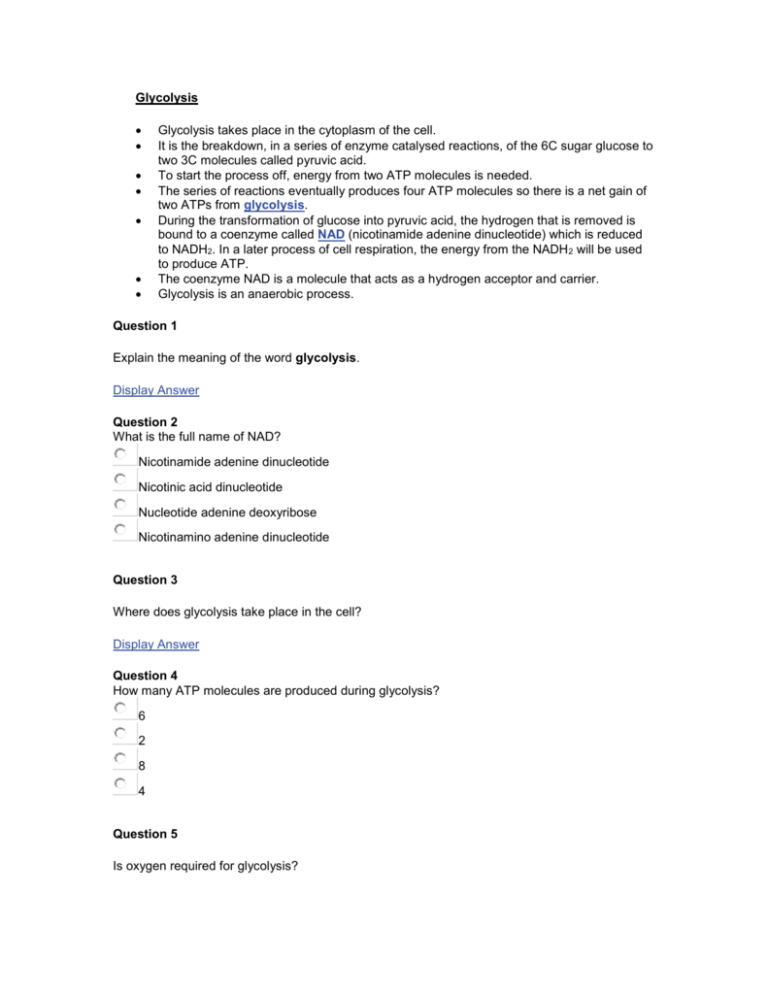
Glycolysis Glycolysis takes place in the cytoplasm of the cell. It is the breakdown, in a series of enzyme catalysed reactions, of the 6C sugar glucose to two 3C molecules called pyruvic acid. To start the process off, energy from two ATP molecules is needed. The series of reactions eventually produces four ATP molecules so there is a net gain of two ATPs from glycolysis. During the transformation of glucose into pyruvic acid, the hydrogen that is removed is bound to a coenzyme called NAD (nicotinamide adenine dinucleotide) which is reduced to NADH2. In a later process of cell respiration, the energy from the NADH 2 will be used to produce ATP. The coenzyme NAD is a molecule that acts as a hydrogen acceptor and carrier. Glycolysis is an anaerobic process. Question 1 Explain the meaning of the word glycolysis. Display Answer Question 2 What is the full name of NAD? Nicotinamide adenine dinucleotide Nicotinic acid dinucleotide Nucleotide adenine deoxyribose Nicotinamino adenine dinucleotide Question 3 Where does glycolysis take place in the cell? Display Answer Question 4 How many ATP molecules are produced during glycolysis? 6 2 8 4 Question 5 Is oxygen required for glycolysis? Display Answer Question 6 Name the final product of glycolysis. Display Answer Kreb cycle In the presence of oxygen, cell respiration continues on from glycolysis in the mitochondria of the cell. Mitochondria are ideally suited to their function in cell respiration as their inner membrane is highly folded to form cristae, presenting a large surface area for the reactions of Krebs cycle to occur. In addition, the fluid-filled interior of a mitochondrion (the matrix) is packed with the enzymes that are required for the process. The site of ATP production in the mitochondria is provided by particles on the cristae. Since mitochondria are the 'energy producing ' organelles of cells, they are present in large numbers in cells that require lots of energy, such as muscle cells, liver cells, sperm cells, and nerve cells. The events of the Krebs cycle (also known as the tricarboxylic acid cycle or the citric acid cycle) are summarised below. Pyruvic acid (produced by glycolysis) diffuses into the matrix of the mitochondrion where it is converted into a 2C compound called acetyl coenzyme A (acetyl CoA). The conversion of pyruvic acid to acetyl CoA releases hydrogen that is bound to NAD to form NADH2. Each acetyl CoA combines with a 4C molecule to form a 6C molecule called citric acid. During Krebs cycle, citric acid is converted through a series of enzyme-catalysed reactions back into the 4C molecule. In the process, both carbon (in the form of carbon dioxide) and hydrogen are released. Hydrogen becomes bound to NAD to form NADH2. This will be used in the next stage of respiration to release energy for ATP production. (In one case, the hydrogen becomes bound to a coenzyme called FAD rather than NAD.) Carbon dioxide diffuses out of the cell as a waste product that is expired from the organism by breathing out or by diffusion over the body surface. Question 1 Explain the meaning of the word glycolysis. Answer Glyco is derived from the Greek word glycos, meaning 'sweet'; lysis is the Greek word for 'loosening'. Glycolysis therefore means the breakdown of glucose. Question 3 Where does glycolysis take place in the cell? Answer In the cytoplasm. Question 5 Is oxygen required for glycolysis? Answer No. Glycolysis is an anaerobic process that does not require oxygen. Question 6 Name the final product of glycolysis. Answer At the end of glycolysis, two molecules of pyruvic acid are formed.
